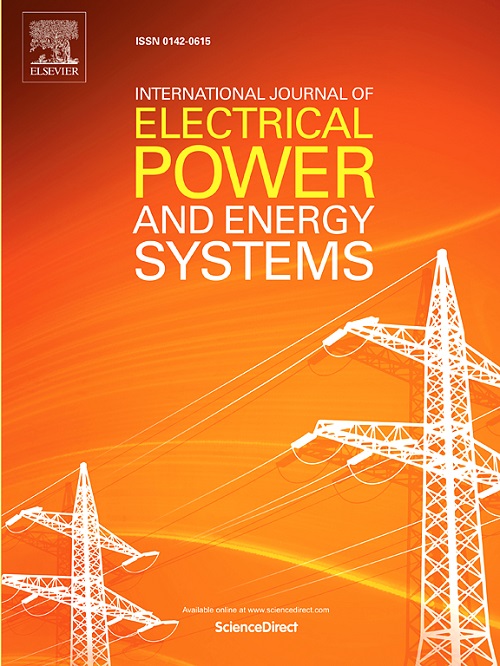Estimation of inertia demand in power systems considering wind power virtual inertia
IF 5
2区 工程技术
Q1 ENGINEERING, ELECTRICAL & ELECTRONIC
International Journal of Electrical Power & Energy Systems
Pub Date : 2025-03-22
DOI:10.1016/j.ijepes.2025.110597
引用次数: 0
Abstract
The high proportion of renewable energy integrated into the grid through numerous power electronic devices has reduced the overall system inertia level and operational stability and caused poor disturbance resistance. Considering the frequency stability of power systems, this study proposes an inertia demand assessment method for renewable energy power systems. The proposed method evaluates the inertia requirements of a power system at a certain level of renewable energy penetration to ensure that the system’s operational frequency stays with the safety boundaries after a system disturbance instead of increasing the inertia level to 100% synchronous machines. This can meet the inertia requirements of a power system while ensuring frequency safety, thus reducing the system’s inertia reserves. In addition, the inertia demand assessment considers the virtual inertia of renewable energy. The proposed method is verified using an IEEE 39 bus time-domain simulation model constructed in the RTLAB simulation environment. The inertia requirements are estimated under different wind power penetration levels of 20%, 40%, and 60%. The proposed method is also compared with the traditional method that uses only the fmin constraint to demonstrate the effectiveness and accuracy of the proposed method in estimating inertia requirements of wind-integrated power systems with virtual inertia. The proposed method is further validated using actual grid data from Yunnan under two operational scenarios corresponding to the wet and dry seasons. The results show that by using both the RoCoFmax and fmin constraints, the proposed method can achieve a more accurate assessment of the inertia level in large-scale wind-integrated power systems with virtual inertia compared to the methods that use only one constraint.
考虑风电虚拟惯性的电力系统惯性需求估算
可再生能源通过众多电力电子设备并网比例过高,降低了整个系统的惯性水平和运行稳定性,抗干扰能力较差。考虑电力系统的频率稳定性,提出了一种可再生能源电力系统的惯性需求评估方法。本文提出的方法是评估在一定可再生能源渗透水平下电力系统的惯性需求,以确保系统在系统扰动后运行频率保持在安全边界内,而不是将惯性水平提高到100%的同步电机。这样可以在保证频率安全的同时满足电力系统的惯量要求,从而减少系统的惯量储备。此外,惯性需求评估还考虑了可再生能源的虚拟惯性。通过在RTLAB仿真环境中构建的IEEE 39总线时域仿真模型,验证了该方法的有效性。在风电渗透率分别为20%、40%和60%的情况下,对惯性需求进行了估算。并与仅使用fmin约束的传统方法进行了比较,验证了该方法在具有虚拟惯性的风力发电系统惯性需求估计中的有效性和准确性。利用云南实际格网数据,在干湿季节两种运行情景下对该方法进行了进一步验证。结果表明,采用RoCoFmax和fmin两种约束条件对大型风力发电系统的惯性水平进行评估,比仅使用一种约束条件的方法更准确。
本文章由计算机程序翻译,如有差异,请以英文原文为准。
求助全文
约1分钟内获得全文
求助全文
来源期刊
CiteScore
12.10
自引率
17.30%
发文量
1022
审稿时长
51 days
期刊介绍:
The journal covers theoretical developments in electrical power and energy systems and their applications. The coverage embraces: generation and network planning; reliability; long and short term operation; expert systems; neural networks; object oriented systems; system control centres; database and information systems; stock and parameter estimation; system security and adequacy; network theory, modelling and computation; small and large system dynamics; dynamic model identification; on-line control including load and switching control; protection; distribution systems; energy economics; impact of non-conventional systems; and man-machine interfaces.
As well as original research papers, the journal publishes short contributions, book reviews and conference reports. All papers are peer-reviewed by at least two referees.

 求助内容:
求助内容: 应助结果提醒方式:
应助结果提醒方式:


